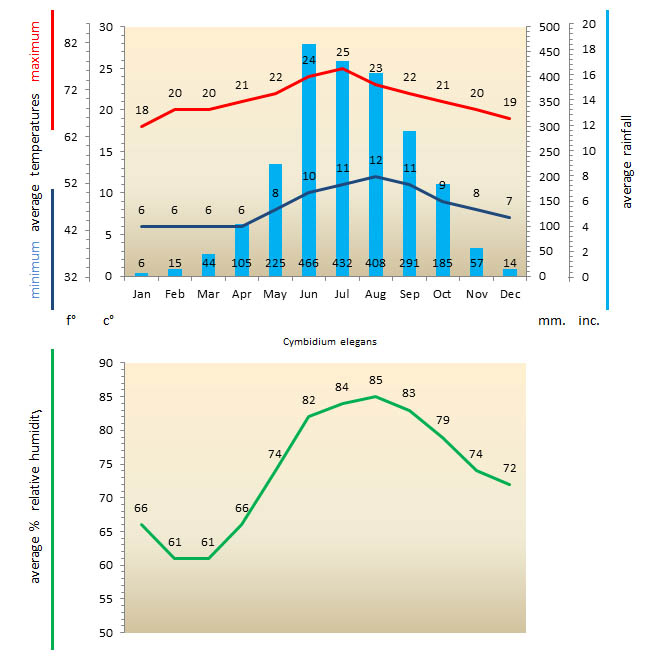| Cymbidium elegans |
| taxonomy | described by | Lindley, John |
| published in | The Genera and Species of Orchidaceous Plants 163 1832 | |
| family | Orchidaceae | |
| subfamily | Epidendroideae | |
| tribe | Cymbidieae | |
| subtribe | Cymbidiinae | |
| genus | Cymbidium Swartz 1799 | |
| chromosomes | 40 (Tropicos / IPCN) | |
| native of | origins | damp, shady forests, sometime overhanging streams, in India (Sikkim, Assam, Meghalaya, Naga Hills,Lushai Hills), Bhutan, Nepal (Tembawa, Suketar), Burma (Chin Hills), |
| Viet Nam, China (Yunnan, Xizang, Zizhiqu,) | ||
| altitude | 230 - 2800 m (760 - 9240 ft) | |
| habitat | temperate to cool | |
| informations on the climate, the weather station Falam (Chin Hills, Chin, Burma) | ||
| temperatures are calculated for an altitude of 1500 m (4950 ft) | ||
 | ||
| life form | epiphyte or litophyte | |
| brightness | partial shade | |
| inflorescence | length | |
| nr flowers | ||
| size | ||
| duration | ||
| time | to bloom from birth, ≈ days | |
| CITIES | appendix | II |
Plants epiphytic or lithophytic, autotrophic. Pseudobulbs subovoid, bilaterally flattened, 4-9 × 2-3 cm, enclosed in persistent leaf bases. Leaves 6-16, distichous, lorate, 45-80 × 1-1.7(-2) cm, articulate 4-10 cm from base, apex acuminate or obtuse and usually slightly 2-lobed. Inflorescence arising from lower part of pseudobulb, usually arching, 40-50 cm; rachis pendulous or nodding, centrifugal or centripetal, densely 18-35-flowered; floral bracts small, 2-3 mm. Flowers slightly fragrant, pendulous, narrowly bell-shaped, not opening widely; pedicel and ovary 12-21 mm; sepals and petals cream-yellow to pale yellowish green, sometimes tinged pale pink; lip cream-yellow to pale yellowish green, occasionally with reddish spots, lamellae bright orange. Sepals narrowly obovate-lanceolate, 34-43 × 7-11 mm, apex acute. Petals broadly linear-oblanceolate, 30-40 × 5-8 mm, apex obtuse; lip oblanceolate-triangular, 30-40 × 4-8 mm, base fused to basal margins of column for 2-3 mm, 3-lobed; lateral lobes loosely clasping column, not ciliate; mid-lobe small, 6-10 × 5-8 mm, margin slightly undulate, apex slightly bilobed and incurved; disk minutely papillate on lateral lobes and densely pubescent at center of mid-lobe, with 2 longitudinal lamellae extending from base of lip to near base of mid-lobe; lamellae sparsely pubescent,
at their apices and with a longitudinal channel between them, sometimes each lamella with a lanceolate appendage 3-5 mm on outside below middle. Column 28-32 mm, puberulent toward base, narrowly winged; pollinia 2, subclavate-obovoid.
Trees in forests, cliffs; 1700-2800 m. SW Sichuan, SE Xizang, Yunnan [Bhutan, India, Myanmar, Nepal, N Vietnam].
References
1.Ref 1
2.Ref 2
3.Ref 3
No comments:
Post a Comment